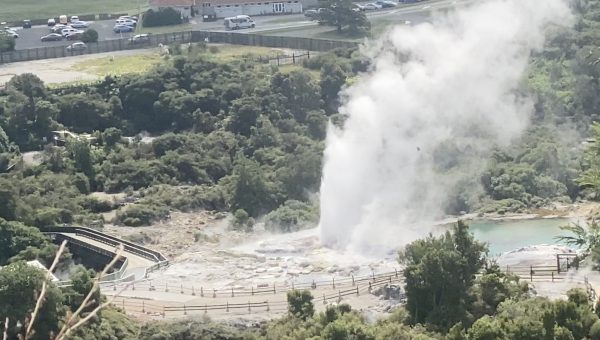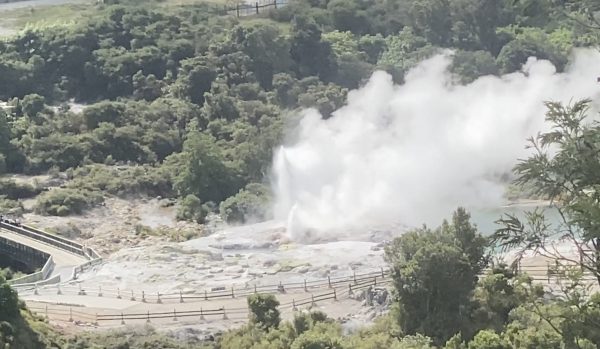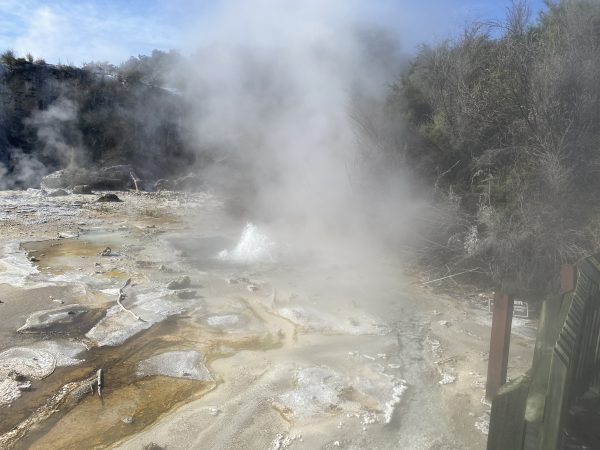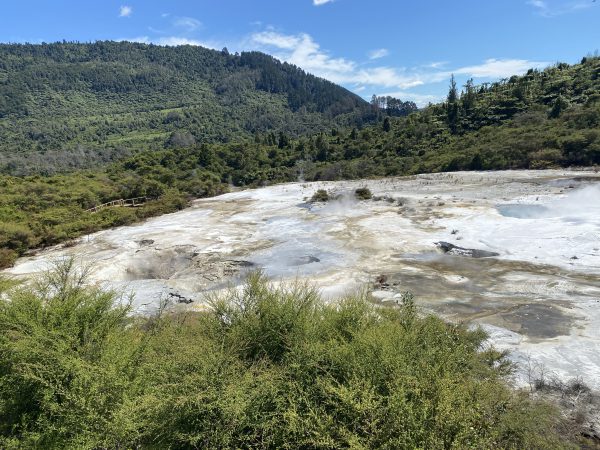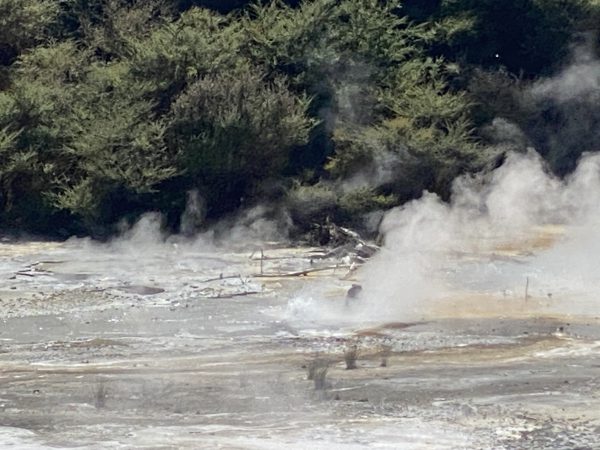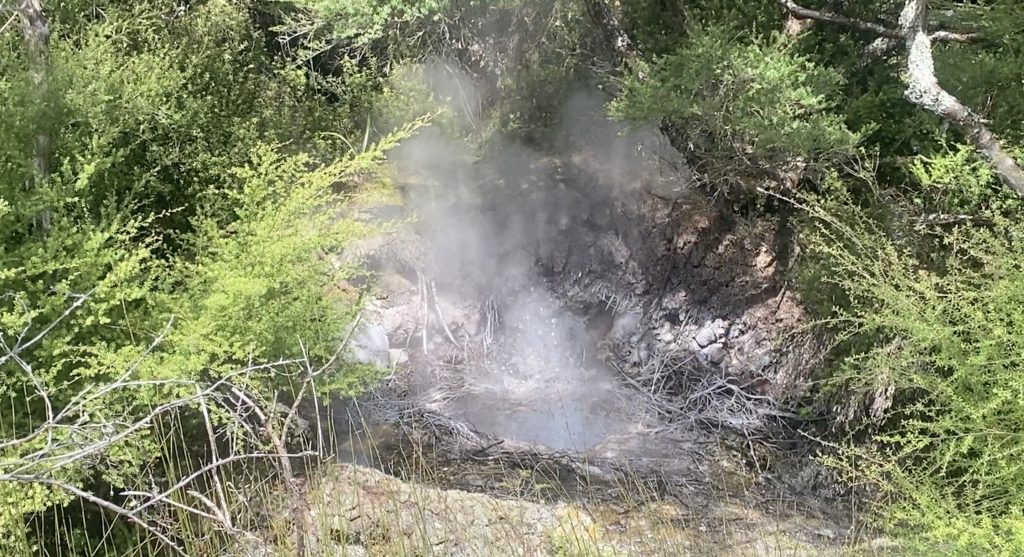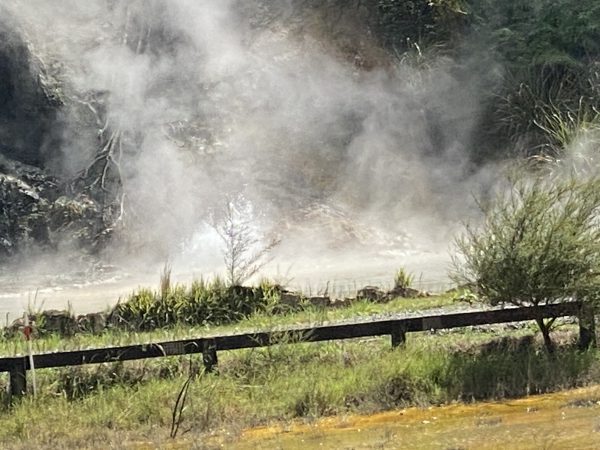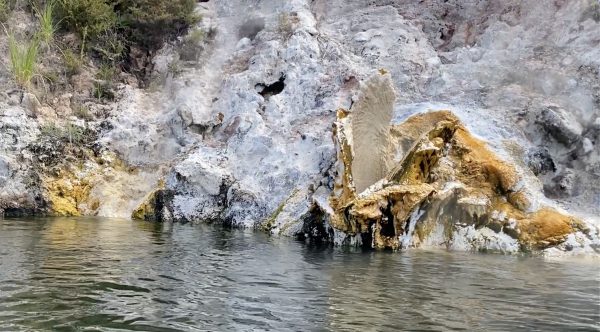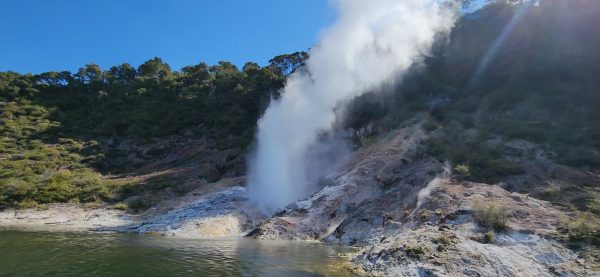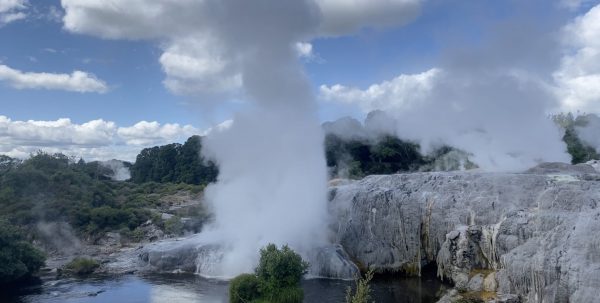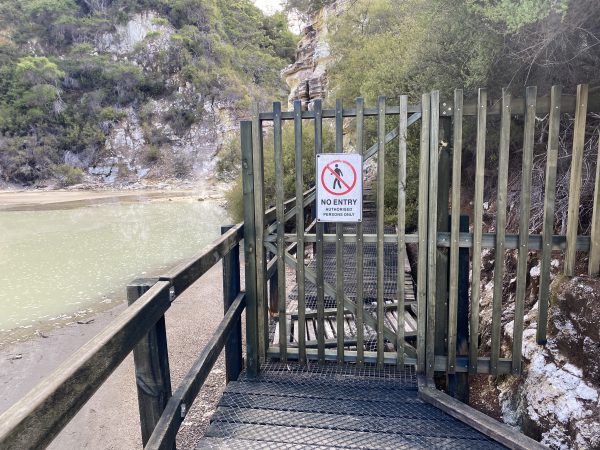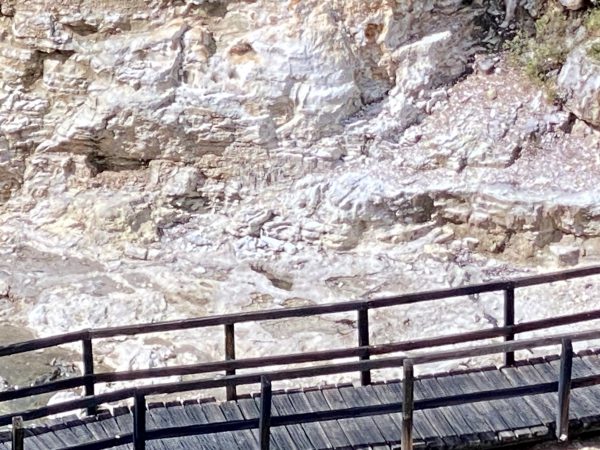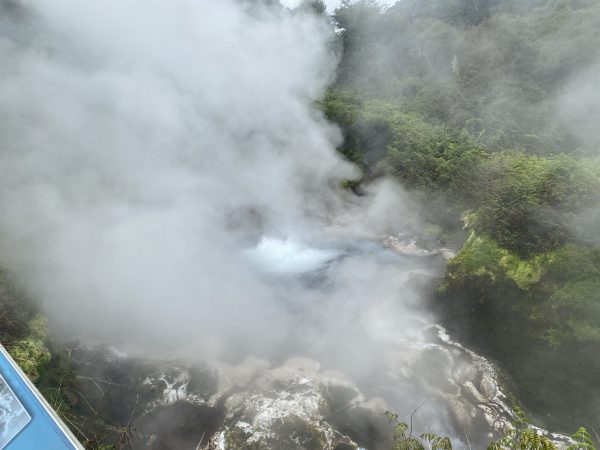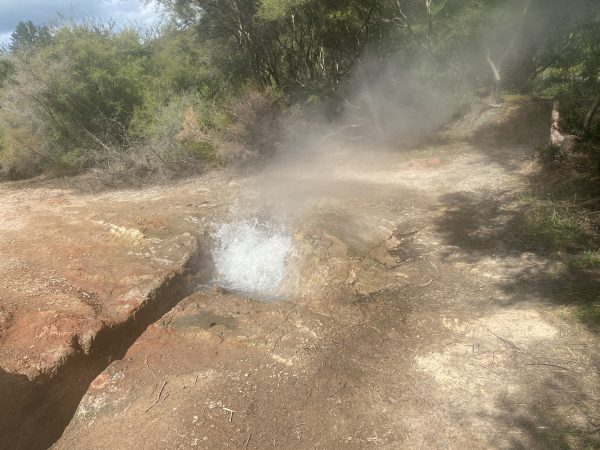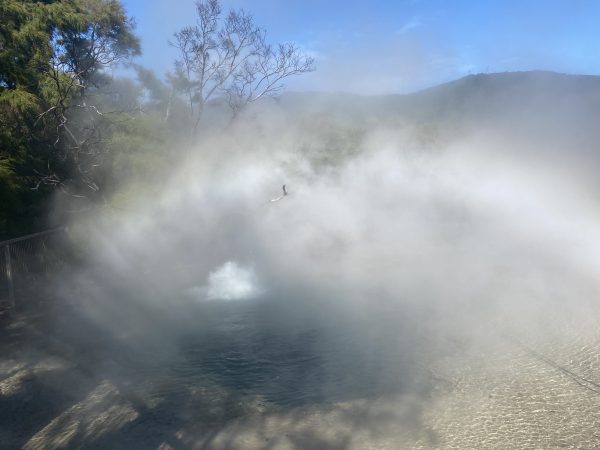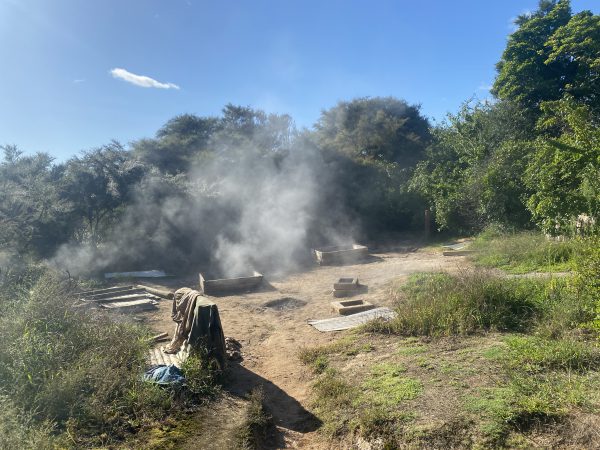Posted on
Month: March 2023
Posted on
Posted on
Kereru Geyser, Whakarewarewa (Te Puia), New Zealand
Posted on
Hoani, Tokaanu, New Zealand
Posted on
Taumatapuhipuhi, Tokaanu, New Zealand
Posted on
Observations for 2023 March 12
Visted the Rotorua lakeshore and the Government Gardens. Once again, most of the features were murky, acid-sulphate springs and formation. Whangapipiro Pool (aka Rachel Spring) was the one clear, alkaline boiling feature behind a rock wall across the street from the lawn bowling and croquet lawns.
On some maps I've seen a trail along the north side of Puarenga Stream north of Whakawerawera. Investigated it and found that other than one large boiling pool, it doesn't provide any better access or views to the features along the stream inside the village.
The afternoon was spent at the geyser overlook along the Pohaturoa Trail in the Whakawerawera Forest Preserve. From there, over a period of about three hours, saw multiple eruptions of all the features on Geyser Flat.
Pohutu seems to have had a short duration eruption, about 15 minutes long, followed by a short interval, about 36 minutes. That eruption was more normal for the last few days, lasting about 45 minutes with an interval of just under 1-1/2 hours. It's interesting that during the last few days, Pohutu was in eruption about half the time, no matter what the duration was.
Saw several series from Mahanga, and again they seemed to be different than previous days, in both length of series and in interval between series. One series was long, about 16 minutes, followed by 34 minutes of quiet. The next series was only a few weak splashes, and then inactivity for 15 minutes. That series duration was almost 20 minutes long, and Mahanga hadn't restarted by the time we left a half hour later.
Finally, we got to see two eruptions of Kereru. The first was a complete surprise, as usual. The second came about 100 minutes later, just as Pohutu was starting. So I should have gotten it on video, but unfortunately I was so zoomed in that the view was bouncing around and I was watching the geysers, not the little screen. So I didn't get much more than some nice still shots.
In any case, we have seen Kereru on four different days, and pairs of eruptions with intervals ranging from around 70 minutes to about two hours. I'd say that Kereru is quite active, or we got extremely lucky.
On the way back, we visited one last thermal feature. Deep in the forest of non-native California Redwoods is a small mudpot. It's probably one of the most unusual settings for a thermal feature that I've encountered.
Posted on
Observations for 2023 March 11
Today was much nicer than yesterday, so it was a day to get out and about. There's more than just geothermal areas in and around Rotorua, and we spent some time on them. But we also visited Tikitere (Hell's Gate) for a couple of hours.
It's sub-divided into several distinct thermal areas, two of which have trails in them. Walked all the trails for a couple of hours. It's another acid sulphate area with many large pools filled with gray water with areas of convection, and lots of sulferous ground. There were a couple of pools with water being thrown a couple of meters high.
At the entrance to the area, next to the bathing pools is a steam vent, which is probably an uncapped steam well. A nice, artificial fumarole.
We didn't visit it on our prior trip, and I doubt we will be visiting it again. Like seeing an eruption of Lady Knox, at least now we know what we are missing.
Posted on
Observations for 2023 March 10
A rainy day, heavy at times, but it got a bit sunny in the early afternoon, so we went to spend a couple of hours in Kuirau Park.
First stop was to take a look at Spring #721. This is the feature which erupted over 100 meters high for 15 minutes on a January Friday back in 2001. Now its just an opaque pool with some slight convection.
Visited the area along Tarewa Street, where several houses had to be abandoned when the springs they were built over reactivated. One of the springs is fairly large and clear and hot, which seems different in an area where most are opaque and acidic. Nearby is another hot feature, which is believe is #712, Parekohoru, that was boiling up about 30cm or so.
Kuirau Lake was steamy thanks to the high humidity from the rains. The boardwalk on the northeast side was fenced off. It looked like the lake might have risen just enough to start flooding and undermining the walkway.
The small spouters next to the Jaycee Thermal Monument seemed pretty much unchanged from the visit four years ago. The same could be said of most of the rest of the features.
After two hours, the rains started up again as we were leaving.
Posted on
Observations for 2023 March 09
Today we returned to the Whakarewarewa thermal area, but on the Maori village side. We got a late start because we misunderstood the types of tours offered. You can't see Korotiotio and Parekohoru on the Geothermal Walks self-guided tour, but need to take the Village Legacy Tour. But that also includes access to the Pohutu viewpoint, where we spent much of our time.
The view of the Geyser Flat, while not close, is still pretty good. You can see enough of Kereru to get an idea of what it is doing, and Mahanga is visible at the same time. We arrived there while Pohutu was active. It was probably early in the eruption of Pohutu, because it continued to erupt for half an hour. We saw the start of a Mahanga series which lasted about 12 minutes.
After 45 minutes or so, Te Tohu started, and almost immediately, we also got an eruption of Kereru. As in the other times we've see it erupt, it seemed to have been quiet before the eruption. Afterwards, it was having strong minors for the next hour or so.
Two hours later, an eruption of Pohutu had come and gone. There were three series of Mahanga eruptions, lasting from 9 to 14 minutes. Pohutu had been erupting for about 12 minutes, and it was three minutes short of two hours when we got to see a second Kereru eruption.
At that point, we took our Geothermal Walk. The area covered is large, with numerous hot pools with occasional mudpots and areas of what appear to be perpetual spouters. The underbrush is thick is many places, hiding features so much that you can hear them, but not see them.
Since we still had an hour before closing, we went back to the overlook, but were blocked out by some tours. By the time we got to the platform, it looked like Kereru was finishing an eruption. Over the next hour, it had many strong minors. Some of these would put up jets of water well above the higher Geyser Flat platform. If that was an eruption, then the interval was about 1-1/2 hour, which fits our previous experiences.
During that time watching the minors, we saw Mahanga end a series, then have another that was still going 19 minutes later, when we finally had to leave the area. At that time Pohutu was still about ten minutes away from another eruption.
Posted on
Observations for 2023 March 08
It was clear when we started the drive, but by the time we got to the junction with State Highway 35, there was fog. It got really thick as we approached the Waiotapu thermal area, and I expected it to clear after that, but it was foggy all the way to Orakeikorako.
We arrived just before a busload of tourists arrived, but got across the lake on the ferry well before they arrived in the thermal area. Over the next twenty minutes, the fog cleared, the air warmed and it was a bright and clear the rest of the day.
The first thing of interest I noted was that Bush Geyser was now visible from the trail. In our previous visit, I didn't even know about it despite it only being a couple of meters off the trail. But back then, it was hidden by think underbrush, which is characteristic of most of the thermal area. Not knowing how it behaves, I was under the assumpt that it was dormant since there was no evidence of any wash zone around the vent. That would prove to be a wrong assumption.
Within the first half hour, we saw eruptions of Cascade and Sapphire. We didn't stick around for intervals, but went onward and upward onto the next terrace. There we found Wairiri Geyser active. The previous visit, four years ago, it was a quiet, cool, brown pool. Now it was boiling and splashing up to a meter high, with copious discharge under the walkway.
Nearby were the new features which had appeared underneath the boardwalk. (Last year I discovered a paper in which a researcher went around finding areas of hot ground. One of the areas, years before the breakouts, was that exact area under the old boardwalk.) They look like they haven't erupted in a long time. Some gurgling could be heard from one of the vents, which was the extent of the activity. The vent closest to Wairiri, on the left, had runoff coated with slime running into it. The boardwalk itself had been replaced since last time, and the undergrowth was already starting to obliterate the old trail in places.
Artists Palette was disappointing. There was almost no water being discharged anywhere. Last visit there was a nice thermal waterfall behind Wairiri and flooding into Dreadnought Geyser. That was gone. All the features on the left, as seen from the overlook shelter were completely drained. Last visit they were full, boiling and featured several pool type geysers.
Feature #812 had been a thin jet perpetual spouter coming out of a broad pool. It was not erupting, and it's pool area looked damp at best. Later in the day we saw #812 erupting, It was much wider and more ragged, and was acting as a true geyser, but did not fill out the pool area. The water was confined to the central vent.
The sounds of an eruption were usually audible from the area to the right of Psyche's Bath, like four years ago. Still have no idea what is causing them.
The only activity that was new was from what I believe is vent #735. This was a perpetual spouter about a half meter high which would cycle up and down over the course of a minute or so, rising and falling abou 30 to 40 centimeters.
On the side of the boardwalk, opposite the terrace as one approaches the junctions and observation shelter is a large, hot pool that I don't remember from the previous visit. It may also have been a case of something being hidden by the underbrush.
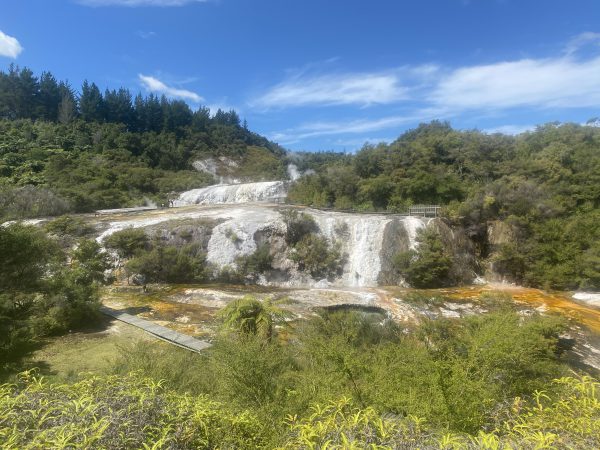
By this time we decided to concentrate on the Emerald Terrace features Sapphire and Cascade. At least there we would be seeing eruptions.There may have been other geysers active on Artists Palette, but we didn't want to spend the time to find out.
We got back and with a few minutes saw eruptions of both Sapphire and Cascade. We were able to infer that either we'd missed an eruption of Sapphire, or it was having shorter intervals than four years ago. As it turned out, Sapphire was having shorter intervals, consistently erupting every 35 to 40 minutes. Between major eruptions, every three minutes or so it would have a short minor eruption episode. At first these consisted of heavy, noisy steam, but as the interval progressed, these would turn into weak splashing lasting maybe 10 seconds. The start of the major eruption almost immediately appeared different and stronger compared to the minors.
The eruptions usually lasted about 1m30s to 1m45s, but some were as short as 1m16s and one eruption had some late splashes pushing the duration past two minutes.
Cascade was having longer intervals than our previous visit, consistently 19 to 20 minutes apart. Otherwise they seemed unchanged from four years ago. The start was sudden. My usual way of catching the start on video was to start recording just before 19 minute mark.
Early in the afternoon I finally got to see activity in Bush. This consisted of a lot of noise, and a single visible splash. Over the next 45 minutes I saw several such episodes, mostly noise but with a splash or two.
At one point, I saw steam visible behind the ridge to the west, where Kurapai should be. It lasted for at least ten minutes, and I didn't see any more steam there the rest of the visit.
As with the other thermal areas we visited, visitation seemed low, with only a few buses visible in the parking lot across the lake.
Then there was a noisy episode which lasted longer. It gradually changed to splashing, always within the crater rim and with almost no discharge. Some of the water droplet may have got about a meter above the rim.
We ended up seeing 16 eruptions of Cascade, and 8 eruptions of Sapphire. The last eruptions were the last possible ones before they area was closed.
We also got to see Pohutu in eruption as we drove past on our way to fuel up our car.
Posted on
Observations for 2023 March 07
Today we visited Waimangu.
Along the shore of the Frying Pan Lake were a number of little noisy spouters. The noisiest, unfortunately, was out sight just below the walkway. Near the outlet at the northeast were a number of areas of convection and bubbling. One would occasionally splash water into the air to a few centimeters high.
Inferno Crater was down at least three meters. The runoff channel still had some brown, stagnant pools in it, but I have no idea how long ago was the previous overflow. The pool was calm and its normal, milky blue color. On the far shore, in a gray debris fan was a small but noisy and wet fumarole, maybe a couple of meters below the high water mark. The debris fans all had many wave cut terraces on them, each maybe a centimeter or two higher than the previous terrace.
The only geyser we saw along the trail was Iodine Spring. It is across the stream and bus road, so not easily visible. But there is a gap between a couple of roadcuts where we could watch the activity. For the five intervals we saw, it was erupting at almost exactly eight minute intervals, with durations just over 1m50s. The spring starts splashing a minute or so before the eruption starts. The eruption height is around three meters, with a jet distinctly angled to the right.
The afternoon was taken up by one of our adventures we scheduled for the trip. We took a two hour kayak tour of the Steaming Cliffs/Donne Cliffs along the shore of Rotomahana. This was our first kayak experience, and we got wet. I mostly figured out how to control the kayak and get it to generally go in the direction intended. I didn't take much video, and no notes, because the kayak had my full attention. We were also fortunate in the the lake was calm, with only a slight breeze, and the sky was clear and mostly cloudless.
The reason for the trip was to have more time with the thermal features along the shoreline, and that was extremely successful. We got within a few feet of the "Angel Wings" feature, and I've seen nothing like that anywhere else.
After that we got to see four eruptions of the Pink Terrace/Otukapuarangi Geyser. Like Iodine Spring, it has an interval of around eight minutes. The eruptions are preceeded by about a minute of overflow, which can be seen coming down a short channel into the lake. The eruption lasted about a minute of so, and jets were easily well over 12 meters high, and noisy.
This was a much better experience for observing geysers than the boat trip we took the previous visit. I'd recommend it as long as you don't mind getting wet, or know what you are doing.
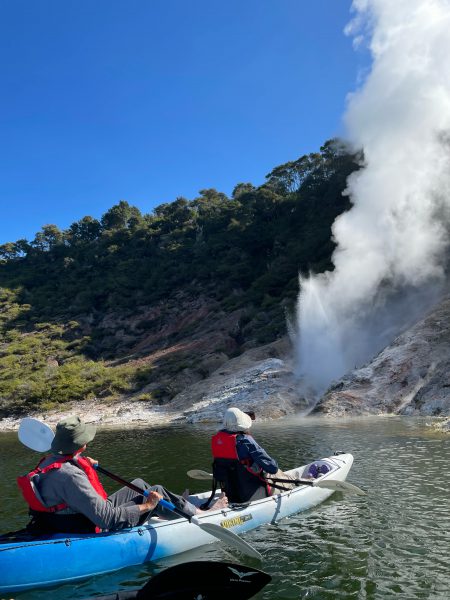
Update: 2023-April 19 — Minor correction to names of features at Steaming Cliffs/Donne Cliffs. Also added another photo of Pink Terrace/Otukapuarangi Geyser.
Posted on
Observations for 2023 March 06
Before we entered the reserve, we did see Pohutu erupting from the same parking lot as yesterday. Looked like it might have been near the start, as it was quite tall.
Inside Te Puia, before you can wander about watching geysers you must first take the 1-1/2 hour tour. We paid our dues. Wasn't a total waste of time, as did get to pass through the kiwi house, where we saw a couple of them wandering about in dark enclosures.
When we finally got to see geysers, Pohutu was in eruption. It continued to erupt for the next 20 minutes. About ten minutes after that, while we were at the high viewing platform, I saw Mahanga splash. This turned out to be the start of a series of eruptions. Every minute or so for the next ten minutes there was an eruption lasting 20 to 40 seconds long, with heights from three to six meters.
Shortly before the series ended, Te Tohu/Prince of Wales Feathers started erupting again. Pohutu started up about 25 minutes later. Then, about six minutes later, another Mahanga series started. The Pohutu eruption lasted about 41 minutes.
Based on our observations through the rest of the day, Mahanga has a series starting about every 35 to 45 minutes, and it is active for about ten minutes. The first activity of the series was usually a splash or two down in the vent, followed by a small eruption, maybe 2-3 meters high. Then the eruptions reached the full height, with the last of the series not much different than any of the others. The indication that it is the end of the series was having several minutes elapse without activity.
During this time, we were checking on Kereru. Every time it seemed to be calm, with a little steam coming from the vent, and no indication of any eruptive potential. We figured it wasn't going to do much, and even at one point returned to the kiwi house for another visit.
At 13:00 we were at the high viewing platform. Te Tohu had started about six minutes earlier, and it had been over twenty minutes since the last activity from Mahanga. So we were thinking of watching the start of both Pohutu and a Mahanga series from there. That's when suddenly Kereru erupted. The water column was easily six to eight meters higher than the edge of the sinter platform that blocked our view of the vent area.
Over the next half hour, Kereru had strong minors every two minutes or so. Some of these were as high as the platform in height. Pohutu started at 13:18, giving us an interval of almost exactly 1-1/2 hours. But after the half hour, Kereru was quiet until about 14:00. Then splashing started in the vent, becoming more vigorous over the next few minutes. It became fairly obvious that something was about to happen, so we were able to record the full start of the next major eruption at 14:05. This eruption lasted 30 seconds, and I estimate the height was from eight to ten meters.
In the aftermath of this eruption, Pohutu quit erupting, giving a duration of about 40 minutes again. But twenty minutes after that, Te Tohu started. It was twenty-six minutes later, at 14:54, that Pohutu started. I watched this start from over by Mahanga (which was quiet), and I would estimate that the height was well over twenty meters. It looked higher than an eruption of Daisy Geyser. There was also the sound of jetting water under pressure coming from what was probably the strongest eruption of the day. Again, the eruption lasted about 40 minutes.
During all this time, Kereru was having minor eruptions every two minutes or so. Most of these looked like they might turn into major eruptions, so we ended up recording many of them.
The next eruption of Te Tohu was followed 24 minutes later by Pohutu, giving an interval of 1h25m. This was our last start of the day, as the area was closing. We stuck around until 16:30, and as we left, Kereru was still having minor play every couple of minutes.
It appears that both Pohutu and Mahanga were extremely regular during our visit. We didn't spend much time observing Mahanga once Kereru erupted, but whenever I expected activity based on a 40 minute series interval, I would see some activity. Kereru, on the other hand, seems to need a period of quiet before it will start a series with a major eruptions. This pattern fits what we saw four years ago. In both cases, Kereru was quiet for several hours before surprising us, then following up with more eruptions after pauses in the minor activity.
It's also interesting how Mahanga has retained so much of the bright yellow sulphur deposits that make up its formations. I've not seen any geyser that has that sort of coloration and looks like it does.
Like Waiotapu yesterday, Te Puia seemed much more empty than it was four years ago. The only time there were any sort of crowds was when the half-hourly tour came through. Between those times we could have the whole area to ourselves. Suzanne was able to revisit the kiwi house and spend about fifteen minutes there alone in the dark. The forced guided tour is annoying, but afterwards the conditions were much better than the previous visit.
(Videos of all this activity will have to wait until I return home and edit the videos into something manageable.)
Posted on
Observations for 2023 March 05
Today it was off to Waiotapu. Most of the features were not much different from our visit four years ago. The biggest change was that there was now some runoff down the Primrose Terrace, especially the bottommost, narrow portion. The water in Devil's Bath/Roto Karikitea is the same industrial green as before.
The other difference is that the walkway past the Waitapu Geyser is closed off. That was a huge disappointment. But fortunately, the geyser is still visible, but from a high, distant vantage point. It is easy to pick out if you know where to look.
From what we could see, the area around the vent was dry. This is probably a good indication that we were there in the middle of the cycle. Late enough that the water from the previous eruption has evaporated, and early enough that the cycles of overflow had not yet started. We decided to not stick around.
We decided against going to see the induced eruption of Lady Knox Geyser. Instead, once the tours stopped around 09:45, we pretty much had the area to ourselves for over an hour.
Unlike the previous visit, there didn't seem to be a huge mass of people appearing after that eruption. The parking lot seemed mostly quiet as we had a picnic lunch, and I didn't see any bus tours during the afternoon. That may be normal, but it seemed that the closure during the middle of the week would be justified for a lack of visitation.
Next up was Waikite, a small area we missed last time. It's the home of Te Manaroa, a boiling cauldron discharging 40-50 liters per second. It's right next to a road, but down in a gully so that the steam collects there, making observations difficult. It continuously boils, occasionally surging to about two meters, although the amount of water being discharged doesn't seem to change.
Nearby is another, small boiling spring. Above it is the discharge from a third spring not visible from the walkway.
Note that there is a NZ$4 entry fee, but this feature is interesting enough to be worth it.
After that, we stopped in at Te Kopia. The mudpots are liquid, with little to no activity. They are also a pale blue color, as if they are in the process of clearing.
The walkway to the boardwalk appears to not have had any vegetation cut back since our last visit four years ago. The stairway was overgrown with wild berry vines with little stickers.
Our drive back from grocery shopping took us past the end of Fenton St. There is a parking lot there where the geysers of Te Puia are sort of visible through a fence when they erupt. We arrived at 17:15 with Te Tohu/Prince of Wales Feathers in eruption. We waited for about fifteen minutes as it erupted, then Pohutu started at 17:31 A few minutes later, at 17:40, we saw the tops of jets of water from Kereru. I would hope that that would be an indication that we will be able to see Kereru up close in the coming days.
Posted on
Observations for 2023 March 04
It was cool and damp when we arrived at Tokaanu. Before going into the Reserve proper, we investigated the features across the road. There we could hear, hidden in the bush, the sounds of splashing. Along the street, there were areas of hot ground, including a spot between the curbstones where a frying pan was forming.
Went into the reserve, and almost immediately things didn't look good. There were two vehicles parked exactly at the spot where there's a gap in the fence to get to Taumatapuhipuhi. On the back of the flatbed truck was a dog that loudly objected my presence anywhere while I was within sight. It barked continuously for several minutes. At one point I heard an eruption hidden by the vehicles, which I assume was Taumatapuhipuhi. I finally decided to walk the loop taking videos and then decide what to do.
As I neared the finish of the loop, I heard the vehicles leave. The way to Taumatapuhipuhi was now open. As it turned out, I heard them leave as I was passing a feature that would become a center of attention during our visit, and so I didn't pay as much attention to that feature as I should have.
Was able to log the times for eight consecutive eruptions of Taumatapuhipuhi, starting with the one I heard. The intervals started long. We had to wait almost 36 minutes to see the eruption after the one I heard. From then on, the intervals decreased so that the last interval we saw was 21 minutes. Because of this, we did miss a couple of the eruptions. The first time that happened, we walked up to see the sinter platform wet and steaming. The second time I did get an "in eruption" time.
The durations of the eruptions varied from 26 to 10 seconds, with the other three durations being about 20 seconds. The heights were about two meters, and wide. I got splashed once standing about three meters from the rim.
The reason we missed eruptions was because we discovered another erupting feature. Named Hoani, it is a wide, deep boiling pool. The central pit was about five meters across, and I could not see any bottom to it. It is located in a broad, tannish colored sinter sheet depression.
When I walked by taking a video, and the video shows that it was quite hot, and full to the rim. I didn't remember any such feature from our visit four years ago. After the first eruption of Taumatapuhipuhi finished, we decided to head back to look at a few features along the trail, and immediately noticed the 30-40cm high boiling on one side of the crater. This boiling built up to well over a meter, then subsided. This activity continued for at least 1h15m, and we probably saw it near the start. At one point, I saw some surges that could have been two meters high. The activity was much like Artemisia.
The walkway was not built with an erupting, boiling spring in mind. There were times when I was walking along that the fog from the eruption was almost scaldingly hot. This steam was condensing on some of the trees, producing a rain below them. We tried to time our visits to Taumatapuhipuhi and spend rest of the time at Hoani, which is why we missed a couple of Taumatapuhipuhi eruptions.
It was after one of those eruptions that we noticed that the pool was quiet again. Previous pauses had lasted only a few seconds, but this one stretched into a minute or more. Then we noticed that the pool was dropping. By the time we left the area, 45 minutes later, Hoani was down 30-40cm, with the outer rim already drying in spots.
Beyond Taumatapuhipuhi is an area that's been heavily "culturally modified." An area of hot ground and frying pans that's been converted into an area for the preparation of hangi, the Maori method of cooking in hot ground.
After almost four hours at Tokaanu, we headed towards Rotorua. There were a couple of minor thermal areas north of Taupo that we had not visited the last time that we were going to try to see.
The first was "Craters of the Moon", where the Karapiti Blowhole was located. The area has been heavily affected by the nearby geothermal powerplants, and consists mostly of subsidence craters with some weak fumaroles scattered about. The only feature of any interest is the replacement for Karapiti, which is up on a hillside and consists of a wet, moderately noisy fumarole and some other noisy fumaroles. This of "A Fumarole" at Fountain Paint Pots.
This area can be bypassed unless you want to see what a destroyed thermal area looks like, or want to complete a checklist.
The second stop was going to be the "Wairakei Thermal Valley". This is an area that used to contain close to a hundred geysers, some playing to over 30 meters. It is now completely overgrown because all the activity has gone into making electric power. Was not looking forward to visiting, but figured should at least see what it looked like. But when we got to the entrance road, we were blocked by a closed sign. In the Taupo area the cyclone of a few weeks earlier had destroyed a significant percentage of the trees in the area. A lot of those trees had their tops snapped off, while others were complete uprooted.
(Earlier in the week, near Tongario National Park, we had to lengthen our hike to a waterfall by an extra 500 meters because the road was blocked in three places by downed trees. The road was low priority for clearance, as it had no other reason for being other than access to that hike.)
Since we had a little time, and we were passing right by, instead we stopped at the Waiotapu Mud Pots. These are in a free area, and well worth a stop. In the pool were a number of active areas spouting mud to as much as three meters high. These areas were periodic, with the longer the quiet period, the more vigorous the activity when it finally did erupt.

